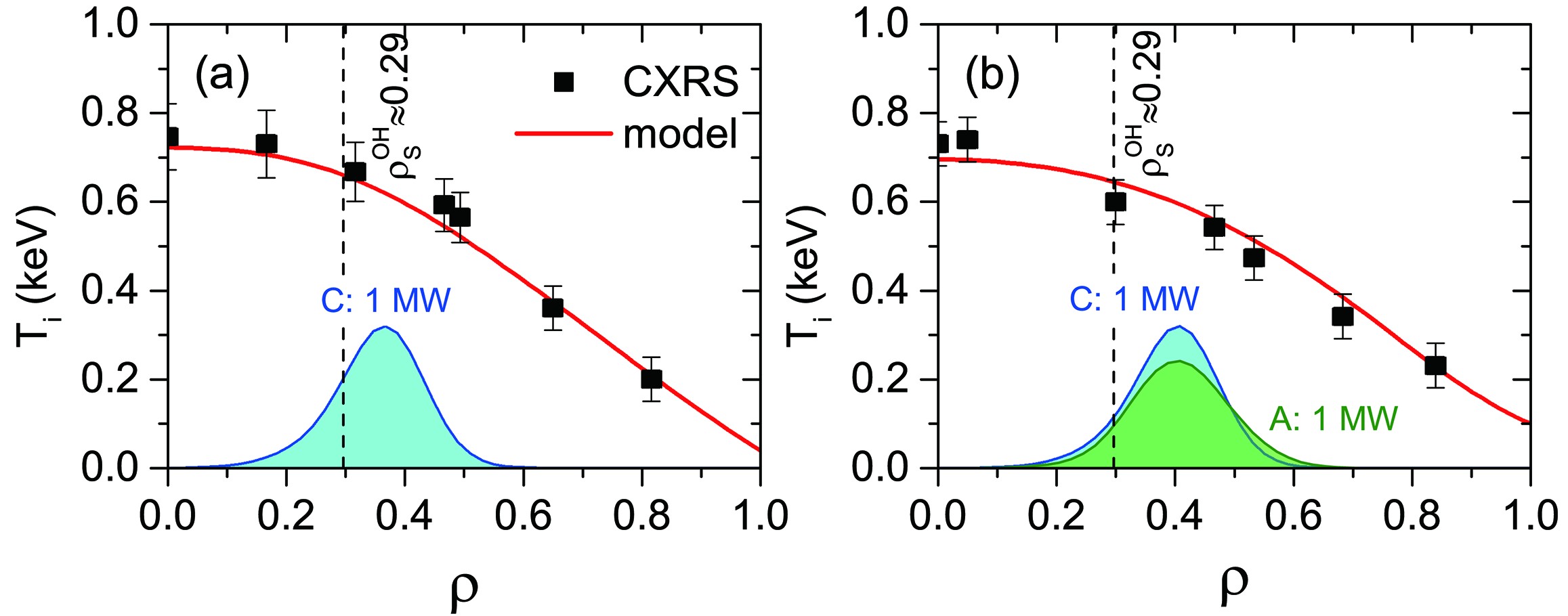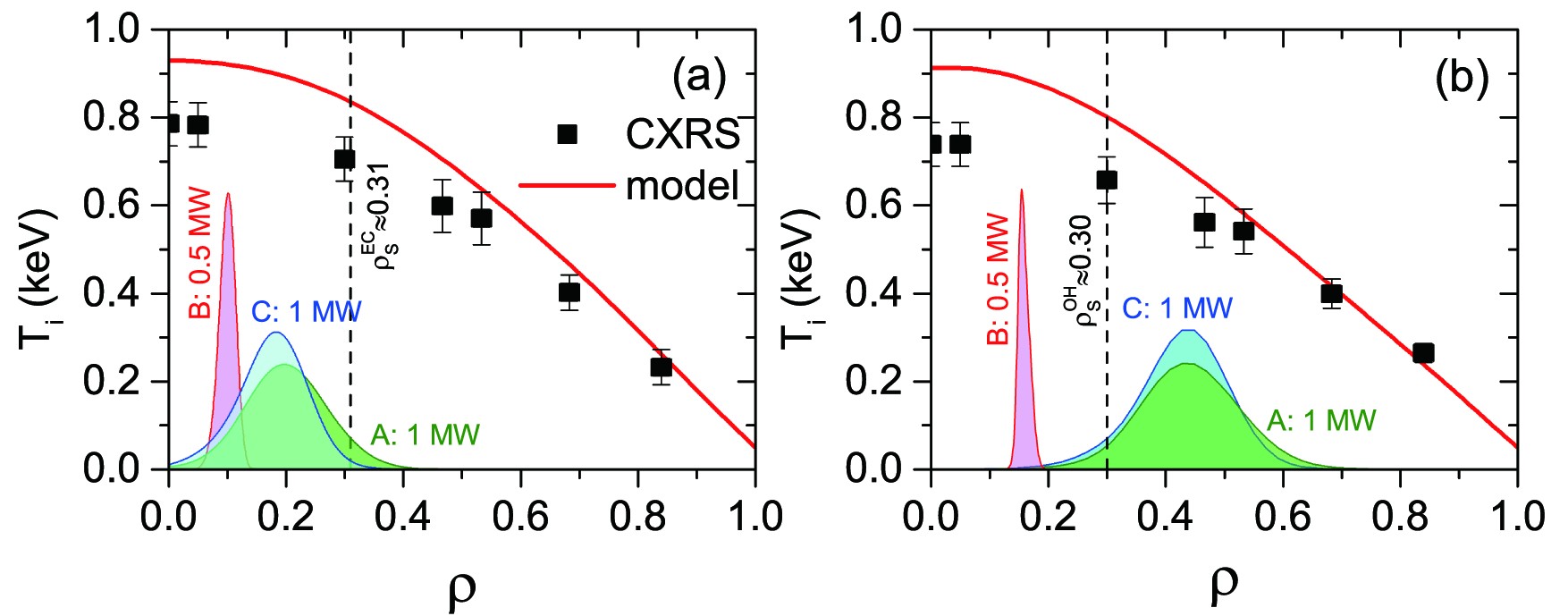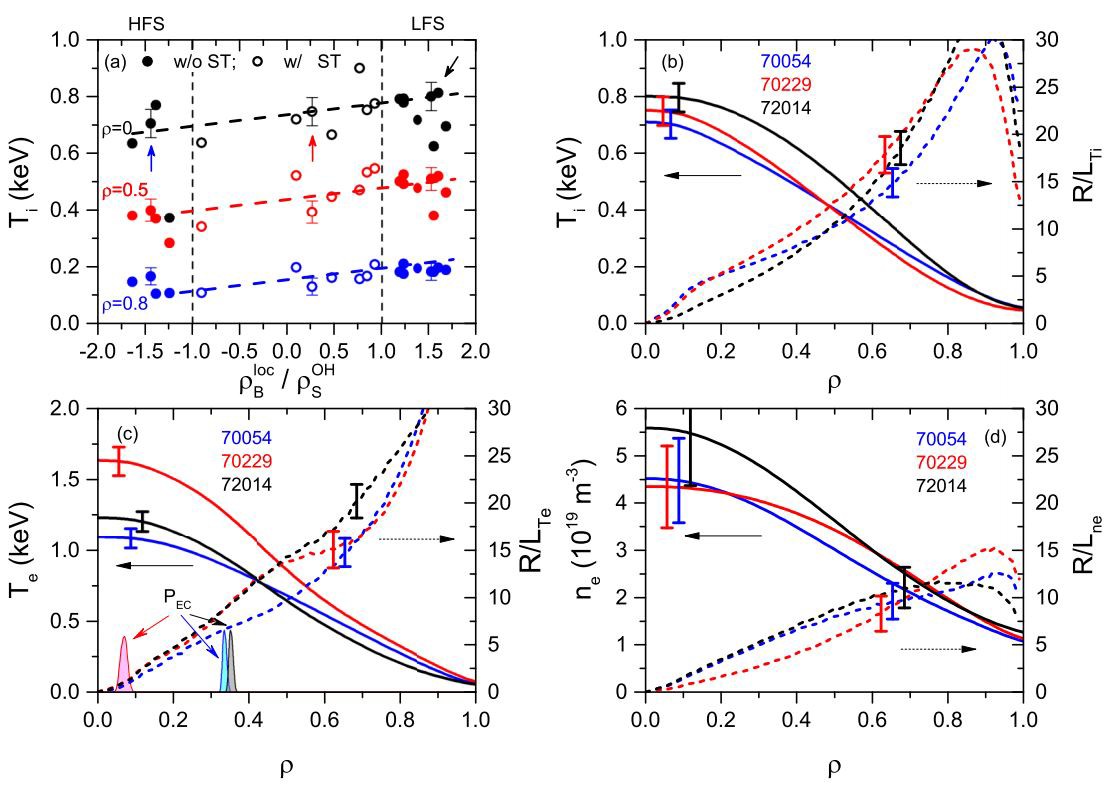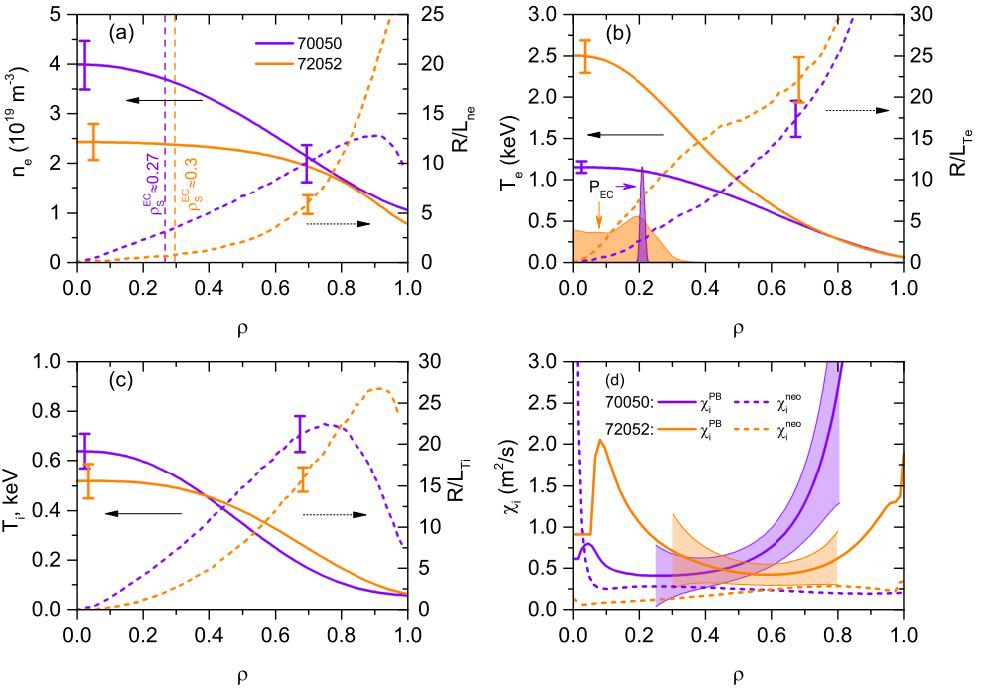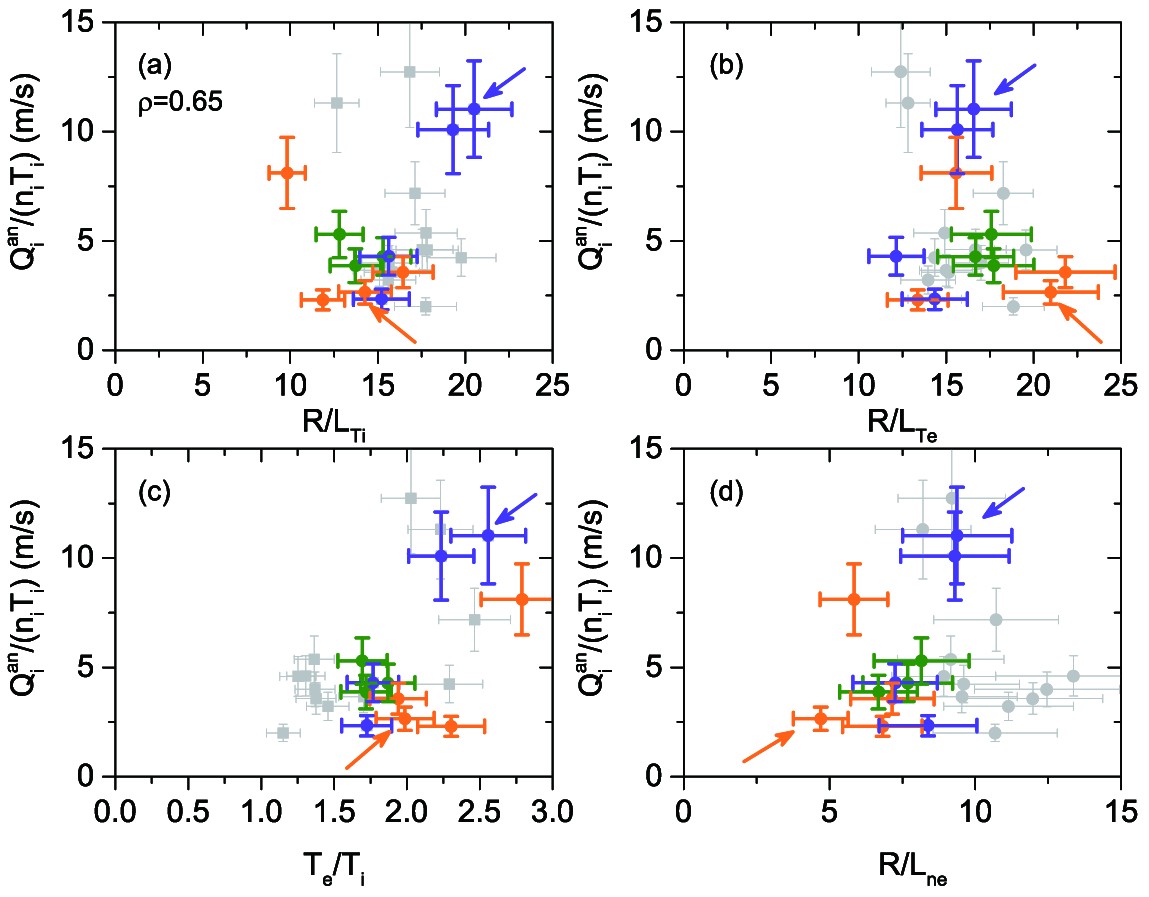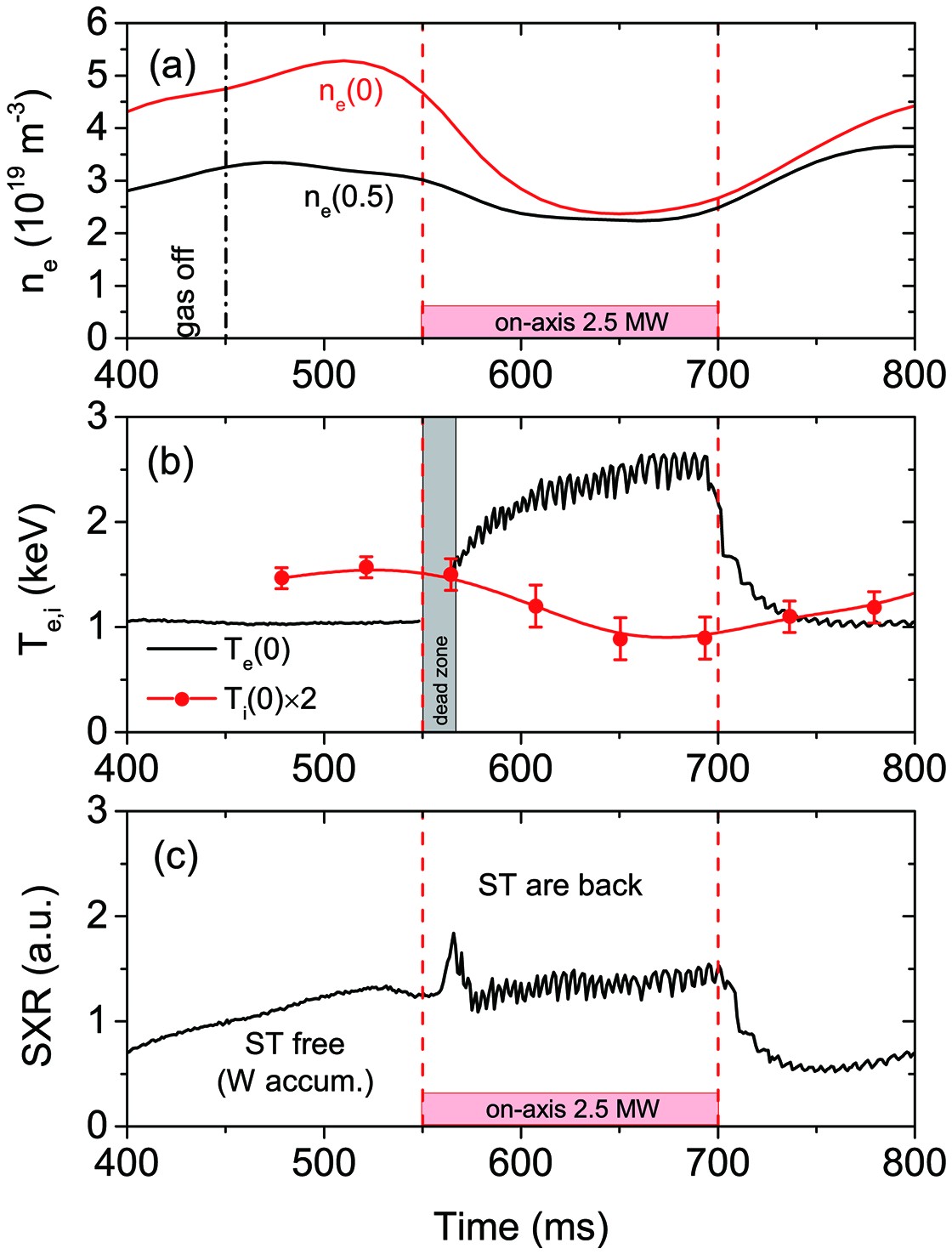
| Citation: | Xingyu CHEN, Mengqi LI, Weiyi WANG, Quanzhi ZHANG, Tao PENG, Zilan XIONG. On the evolution and formation of discharge morphology in pulsed dielectric barrier discharge[J]. Plasma Science and Technology, 2024, 26(4): 045403. DOI: 10.1088/2058-6272/ad13e4 |
The discharge morphology of pulsed dielectric barrier discharge (PDBD) plays important roles in its applications. Here, we systematically investigated the effects of the voltage amplitude, discharge gap, and O2 content on the PDBD morphology, and revealed the possible underlying mechanism of the U-shaped formation. First, the morphological evolution under different conditions was recorded. A unique U-shaped region appears in the middle edge region when the gap is larger than 2 mm, while the entire discharge region remains columnar under a 2 mm gap in He PDBD. The width of the discharge and the U-shaped region increase with the increase in voltage, and decrease with the increase of the gap and O2 content. To explain this phenomenon, a two-dimensional symmetric model was developed to simulate the spatiotemporal evolution of different species and calculate the electric thrust. The discharge morphology evolution directly corresponds to the excited-state atomic reduction process. The electric thrust on the charged particles mainly determines the reaction region and strongly influences the U-shaped formation. When the gap is less than 2 mm, the electric thrust is homogeneous throughout the entire region, resulting in a columnar shape. However, when the gap is larger than 2 mm or O2 is added, the electric thrust in the edge region becomes greater than that in the middle, leading to the U-shaped formation. Furthermore, in He PDBD, the charged particles generating electric thrust are mainly electrons and helium ions, while in He/O2 PDBD those that generate electric thrust at the outer edge of the electrode surface are mainly various oxygen-containing ions.
Electron cyclotron resonance heating (ECRH) is a well-known and widely used technique for heating electrons in fusion devices. Regimes with pure ECRH are suggested to be a simulator for burning plasma [1, 2]. Ions in such regimes are heated only by Coulomb collisions with electrons that provide a broad ion heat source.
Unfortunately, the central ion temperature in ECRH regimes does not tend to be high, even in high-ECRH power experiments (see for example the most recent results from W7-X [3]). The injection of ECRH leads to an increase in turbulent transport that compensates the possible increase of the ion heat source Pei∝Te−TiT1.5en2e due to the rise of (Te−Ti).
It is shown on LHD that neutral beam heating injection may help to achieve a simultaneously high Te and high Ti regime [4]. However, the ion temperature profile flattens in the central region ρ<0.3 due to the on-axis ECRH. The increase in ion heat transport in regimes with ECRH is also observed in DIII-D: by a factor of ∼6 in L-mode [5] and by a factor of ∼1.5−3 in H-mode [6]. The most comprehensive analysis of electron and ion heat transport in L-mode regimes on ASDEX Upgrade using the quasilinear gyrokinetic transport model TGLF [7] can be found in reference [8]. The authors managed not only to reproduce electron and ion temperatures, but also to model their dependencies on general engineering plasma parameters. However, TGLF-SAT2 predictions overestimate ion heat transport in high-ECRH power regimes, which results in the underestimation of the central ion temperature.
The vast majority of published studies of ion heat transport in ECRH regimes are limited to on-axis ECRH, while off-axis heating has not been considered in detail. In this study, we aimed to investigate in which regimes high anomalous ion heat transport can be obtained, and how it is related to the different ECRH regimes.
The description of the T-10 tokamak and its diagnostic complex used for power balance analysis is given in reference [9]. For the purposes of this work, we use the following diagnostics:
• CXRS diagnostics for ion temperature, Ti, and light impurity density measurements, nZ;
• 16-channel interferometry for electron density measurements, ne;
• ECE diagnostics and soft X-ray spectroscopy for measurements of electron temperature, Te;
• bremsstrahlung diagnostics in visible region for effective ionic charge measurements, Zeff;
• passive spectroscopy in visible range for control of impurities and working gas atom influx.
We consider regimes with ECR heating with second-harmonic extra-ordinary mode. There are three available gyrotrons on T-10:
(1) “A”: PEC⩽ MW, f =140 GHz, 200 ms length, can be rotated in poloidal rotation, co-electron cyclotron current drive (ECCD).
(2) “B”: P_{\rm {EC}} \leqslant0.5 MW, f =129 GHz, 400 ms length, injection perpendicular to current direction.
(3) “C”: P_{\rm {EC}}\leqslant1 MW, frequency f =140 GHz, 200 ms length, can be rotated in toroidal rotation, co-/counter-ECCD.
We distinguish the three regimes of ECRH with regard to the sawtooth inversion radius, which varies within the range \rho_{\rm S}=0.17 –0.33 in the Ohmic heating stage:
(1) Off-axis, if resonance zone is outside \rho_{\rm S} .
(2) On-axis, if resonance zone is inside \rho_{\rm S} .
(3) Mixed, if off-axis and on-axis heating are presented simultaneously.
An example of a shot with on-axis heating is presented in figure 1. In shot 72052, ECRH started at 550 ms with all three gyrotrons (injected power P_{\rm {EC}} = 2.5 MW). Due to the pump-out effect [10], the electron density profile, n_{\rm e}(\rho) , becomes flatter. The central electron temperature, T_{\rm e}(0) , rises up to 2.5 keV while the ion temperature, T_{\rm{i}}(0) , decreases from 0.7 keV to 0.45 keV. The sawtooth activity that was suppressed by impurity accumulation during the Ohmic stage is restored as a result of impurity removal [11]. The possible change of toroidal rotation [12] with ECRH is not observed in T-10. The reason is the very low values of toroidal rotation velocities ( \sim10-15 km/s), which is the diagnostic sensitivity limit. After switching the ECRH off, the density and temperatures return to their Ohmic values.
The off-axis and mixed ECRH are shown in figure 2. The off-axis gyrotron B starts at 570 ms with P_{\rm {EC}} = 0.5 MW, and results in density peaking and a slight electron T_{\rm e}(0) (from 0.95 to 1.2 keV) and ion T_{\rm{i}}(0) (from 0.6 to 0.8 keV) increase. The sawteeth at the off-axis stage are suppressed due to the electron temperature broadening. It is necessary to note that off-axis ECRH leads to impurity density peaking due to the formation of positive convective velocities [13, 14]. Such effects are also observed in the considered discharges but they go beyond the scope of the present work. At 775 ms, on-axis gyrotron C with P_{\rm {EC}}=1 MW and 18{\text{°}} counter-ECCD starts. While n_{\rm e}(\rho) flattening does not appear, gyrotron C gives rise to the effects of the on-axis heating: T_{\rm e}(0) increases and T_{\rm{i}}(0) decreases. Due to the counter-ECCD injection, the sawteeth remain suppressed and MHD activity is not observed.
In this section we examine if the change of plasma parameters is enough to describe the reduction of ion temperature in ECRH regimes. To do so we use an empirical scaling of anomalous ion heat conductivity [9] obtained for Ohmic regimes to calculate ion temperature profiles. The ion heat conductivity is taken as follows:
| \begin{array}{*{20}{l}}\chi_{\rm{i}}=\chi_{\rm{i}}^{\rm{neo}}+\chi_{\rm{i-scaling}}^{\rm{an}}+\chi_{\rm{ST}},\end{array} | (1) |
where \chi_{\rm{i}}^{\rm {neo}} is the neoclassical heat conductivity calculated using the NCLASS code [15], \chi_{\rm {i-scaling}}^{\rm {an}} is the scaling for the Ohmic regimes on T-10 [9], \chi_{\rm {ST}}=r_{\rm {ST}}^2/\tau_{\rm {ST}} is the ion heat conductivity inside the sawtooth inversion radius, and \tau_{\rm {ST}} is the sawtooth oscillation period. In sawtooth-free regimes, \chi_{\rm {ST}}=0 . The electron temperature and density profiles are prescribed and taken from measurements.
Figure 3 shows the modeling results for shot 71864. This shot is sawtooth-free at the ECRH stages. Both the Ohmic and the off-axis ECRH stages with 0.5 MW are well described by the model (1) (see figures 3(a) and (b)). At the stage with mixed heating, the calculated T_{\rm{i}} exceeds the experimental points by \sim100 eV in the center.
In shots 72769 and 72983 the off-axis ECRH is applied with higher power. As shown in figure 4, the calculated ion temperature is matched well within the measurements even with 2 MW heating and suppressed sawtooth oscillation.
On-axis heating with 2.5 MW does not exhibit a significant change in the values of T_{\rm{i}} modeled by (1). One can see in figures 5(a) and (b) that the excess by \sim100 eV at the center persists regardless of the on-axis ECRH power. It also seems to be irrelevant whether the EC injection is co-ECCD or counter-ECCD, and whether the discharge has sawtooth oscillations or not.
Therefore, for some shots, model (1) (and even more so neoclassical heat conductivity) overestimates the experimental data and the increase of transport coefficients is required.
In order to analyze how the position of ECR heating affects the ion heat conductivity, we change the toroidal magnetic field, B_{\rm {t0}} , to shift the EC resonance zone of the gyrotron B – \rho_{\rm B}^{\rm {loc}} . The variance of B_{\rm {t0}} = 2.15 –2.53 T corresponds to the change of \rho_{\rm B}^{\rm {loc}} from -0.41 (high-field side, HFS) to 0.45 (low-field side, LFS). The resonance zone position is calculated using OGRAY code [16]. Being directed perpendicular to the magnetic field gyrotron B provides a narrow power deposition profile and zero current drive. It allows us to use the loop voltage and sawtooth inversion radius as indicators for gross errors of T_{\rm e}(r) by modeling the current density profile. Selected for analysis discharges are done with I_{\rm {pl}}=180 –250 kA, which corresponds to q_a=2.9 –3.72. While the majority of experiments have been performed with I_{\rm {pl}}=220 kA, we have to consider the different plasma currents to cover the maximal possible range of EC resonance positions.
In ECR-heated plasma with the gyrotron B ion temperature is higher in shots with higher B_{\rm {t0}} . As shown in figure 6(a), off-axis heating on the LFS (points with \rho_{\rm B}^{\rm {loc}}/\rho_{\rm S}^{\rm {OH}}>1.0 ) provides higher T_{\rm{i}} by 20\% – 30\% . On-axis heating (points -1.0<\rho_{\rm B}^{\rm {loc}}/\rho_{\rm S}^{\rm {OH}}<1.0 ) is obtained in the presence of sawteeth. The three arrows indicate three shots that are used for profile analysis. The selection criterion is the smallest deviation from the T_{\rm{i}}(0) trend.
Kinetic profiles for shots 70054 ( \rho_{\rm B}^{\rm {loc}}/\rho_{\rm S}^{\rm {OH}}=-1.44 ), 70229 ( \rho_{\rm {B}}^{\rm {loc}}/\rho_{\rm S}^{\rm {OH}}=0.27 ), and 72014 ( \rho_{\rm B}^{\rm {loc}}/\rho_{\rm S}^{\rm {OH}}=1.54 ) are given in figures 6(b)–(d). The ion temperature is more peaked in the case of on-axis heating. In zone \rho>0.5 , the normalized gradient length, R/L_{T_{\rm{i}}} , is higher in the case of on-axis and LFS off-axis ECRH. Clearly, the electron temperature is higher with on-axis ECRH, but the normalized gradient length, R/L_{T_{\rm e}} , is almost the same in comparison with the LFS off-axis ECRH. The electron density is flattening with the on-axis heating due to the density pump-out effect. The LFS and HFS off-axis ECRH provides similarly peaked density profiles.
HFS off-axis ECRH results in lower electron temperature gradients than LFS off-axis ECRH. Herewith the density stays narrow, and its normalized gradient length, R/L_{n_{\rm e}} , is comparable to R/L_{T_{\rm{i}}} in \rho=0.4 –0.7.
To obtain the ion heat conductivity we use the power balance technique:
| \chi_{\rm{i}}^{\rm{PB}}=-\frac{Q_{\rm{i}}}{n_{\rm{i}}\frac{\delta T_{\rm{i}}}{\delta\rho}}=-\frac{\frac{1}{S_{\rho}}\int_0^{\rho}(P_{\rm{ei}}-P_{\rm{CX}})V^{'}\mathrm{d}x-\frac{5}{2}T_{\rm{i}}\Gamma_{\rm{i}}}{n_{\rm{i}}\frac{\delta T_{\rm{i}}}{\delta\rho}}, | (2) |
where Q_{\rm{i}} is the ion heat flux, n_{\rm{i}} is the ion density, P_{\rm {ei}} is the electron to ion heat transfer due to Coulomb collisions [17], P_{\rm {CX}} is the loss due to the charge exchange of deuterons with deuterium atoms, \Gamma_{\rm{i}} is the ion particle flux, S_\rho is the magnetic surface area, and V^{\prime} is the volume derivative. More details on the ion power balance methodology and its sensitivity analysis on T-10 can be found in reference [9].
The ion heat conductivity profiles obtained by equation (2) are presented in figures 7(a)–(c) in comparison with neoclassical heat conductivity, \chi_{\rm{i}}^{\rm {neo}} , calculated using NCLASS code [15]. Whereas the highest excess over neoclassical theory is observed with on-axis ECRH, HFS off-axis ECRH gives \chi_{\rm{i}}^{\rm {PB}} very close to \chi_{\rm{i}}^{\rm {neo}} . Let us distinguish the anomalous heat flux, Q_{\rm{i}}^{\rm {an}} , by subtracting the neoclassical flux, Q_{\rm{i}}^{\rm {neo}}=-\chi_{\rm{i}}^{\rm {neo}}n_{\rm{i}}\dfrac{\partial T_{\rm{i}}}{\partial \rho} , from the numerator in equation (2):
| \begin{array}{*{20}{l}} Q_{\rm{i}}^{\rm {an}}=Q_{\rm{i}} - Q_{\rm{i}}^{\rm {neo}}. \end{array} | (3) |
In order to make heat flux a transport characteristic it is possible to divide it by n_{\rm{i}}\dfrac{\partial T_{\rm{i}}}{\partial \rho} and obtain the quasilinear heat conductivity coefficient as in equation (2). Another opportunity is to divide it by the ion pressure n_{\rm{i}} T_{\rm{i}} to obtain the quantity with the dimension of (m/s). The relation of these two approaches is obvious:
| \frac{Q_{\rm{i}}^{\rm {an}}}{n_{\rm{i}} T_{\rm{i}}}=-\chi_{\rm{i}}^{\rm {an}}\frac{1}{T_{\rm{i}}}\frac{\partial T_{\rm{i}}}{\partial \rho}. | (4) |
Since we consider regimes without auxiliary ion heating, the ion temperature gradients do not change significantly ( R/L_{T_{\rm{i}}}=15\pm5 ). Therefore, the change in normalized heat flux directly reflects the change in the transport coefficient.
One can see in figure 8 that the normalized anomalous ion heat flux would be higher in shot 70229. The dependence of Q_{\rm{i}}^{\rm {an}}/(n_{\rm{i}} T_{\rm{i}}) on R/L_{T_{\rm{i}}} is given in figure 9(a). While we can obtain high and low values of Q_{\rm{i}}^{\rm {an}}/(n_{\rm{i}} T_{\rm{i}}) in all three heating regimes, the trend is different. On-axis ECRH provides a positive slope. LFS off-axis ECRH provides a negative slope that could be considered as a “negative stiffness” effect [1, 18]. It is possible to see in figure 9(b) that similar dependencies are observed on R/L_{T_{\rm e}} . It is shown in figure 9(c) that a high T_{\rm e}/T_{\rm{i}} ratio correlates with high Q_{\rm{i}}^{\rm {an}}/(n_{\rm{i}} T_{\rm{i}}) values.
An interesting result can be seen in figure 9(d). Higher density gradients correlate with a lower T_{\rm e}/T_{\rm{i}} ratio and lower anomalous ion heat flux. It seems that in the T-10 plasma electron and ion turbulent modes exist simultaneously and their interaction could determine the ion heat transport. It would also explain the strictly opposite dependencies on the plasma parameters of the ion heat conductivity compared to the electron heat conductivity [19] and impurity diffusion [20].
Together with plasma parameters and their gradients, the ion–ion \nu_{\rm {ii}}^{\ast} and electron–ion \nu_{\rm {ei}}^{\ast} collisionalities are also changed. Figure 10 shows the dependence on collisionalities calculated for the middle radius \rho = 0.5 as follows [21]:
| \nu_{\rm {ii}}^{\ast} = \nu_{\rm {ii}}\left( \frac{m_{\rm d}}{T_{\rm{i}}}\right)^{0.5}\left(\frac{R_0}{r}\right)^{1.5} q R_0, | (5) |
| \nu_{\rm {ei}}^{\ast} = \nu_{\rm {ei}}\left( \frac{m_{\rm e}}{T_{\rm e}}\right)^{0.5}\left(\frac{R_0}{r}\right)^{1.5} q R_0, | (6) |
where \nu_{\rm {ii}} and \nu_{\rm {ei}} are ion–ion and electron–ion Coulomb collisions frequencies, respectively, m_{\rm d} and m_{\rm e} are the deuteron and electron masses, R_0 is the major radius, r is the local minor radius, and q is the safety factor.
High values of Q_{\rm{i}}^{\rm {an}}/(n_{\rm{i}} T_{\rm{i}}) correspond to high ion–ion collisionality, as shown in figure 10(a). Moreover, the change of \nu_{\rm {ii}}^{\ast} is responsible for the negative slope observed for LFS off-axis ECRH points in figure 9(a). The dependence on the electron–ion collisionality is rather flat (see figure 10(b) for both high and low Q_{\rm{i}}^{\rm {an}}/(n_{\rm{i}} T_{\rm{i}}) regimes.
In this section we consider on-axis and mixed ECRH with different power. In order to perform the scan over EC power we choose shots with one (B), two (B and C), or three (A, B, and C) gyrotrons. The absorbed power, P_{\rm {EC}}^{\rm {abs}} , is calculated using the OGRAY code. With higher P_{\rm {EC}}^{\rm {abs}} , the central electron temperature is higher while the central ion temperature does not change significantly. This result is shown in figure 11.
The parameter profiles are given in figures 12(a)–(c) for two shots with low ( P_{\rm {EC}}^{\rm {abs}} = 0.4 MW) and high ( P_{\rm {EC}}^{\rm {abs}} = 1.88 MW) ECRH power. The density profile is significantly flatter in shot 72052 ( P_{\rm {EC}}^{\rm {abs}} = 1.88 MW). Its normalized gradient lengths approximately lower by a factor of 2 compared with shot 70050 ( P_{\rm {EC}}^{\rm {abs}} = 0.4 MW). Higher on-axis power heating results in a higher T_{\rm e} in the central region and higher electron temperature gradients. While T_{\rm{i}}(0) remains almost unchanged, the ion temperature profile flattens with the P_{\rm {EC}} increase. Figure 12(d) shows the resulting ion heat conductivity. In plasma with high ion heat transport power balance conductivity exceeds neoclassical one up to 10 times.
Let us consider again the dependencies of the normalized anomalous heat flux Q_{\rm{i}}^{\rm {an}}/(n_{\rm{i}} T_{\rm{i}}) at \rho=0.65 on the different plasma parameters. Plots are given in figures 13(a)–(c). The colour of the dots indicates the power group from figure 11. The gray dots are reproduced from figure 9. A higher EC power results in a lower R/L_{T_{\rm{i}}} and higher R/L_{T_{\rm e}} , which corresponds to a lower anomalous ion heat flux (see figures 13(a) and (b)). In comparison with the scan over resonance zone, the power scan does not provide us with a greater T_{\rm e}/T_{\rm{i}} range at \rho=0.65 (see figure 13(c)), and the tendency is the same: a higher T_{\rm e}/T_{\rm{i}} corresponds to a higher Q_{\rm{i}}^{\rm {an}}/(n_{\rm{i}} T_{\rm{i}}) . The dependence on R/L_{n_{\rm e}} looks different to figure 9(d). One can see in figure 13(d) that a higher EC power leads to lower density gradient lengths. Points with lower R/L_{n_{\rm e}} allow us to see that a high T_{\rm e}/T_{\rm{i}} ratio can be obtained only with a certain R/L_{n_{\rm e}} =6-10 .
In contrast to figure 10(a), the P_{\rm {EC}} scan does not show such a clear dependence on \nu_{\rm {ii}}^{\ast} (see figure 14(a)). Points with low Q_{\rm{i}}^{\rm {an}}/(n_{\rm{i}} T_{\rm{i}}) that are obtained with low R/L_{n_{\rm e}} are independent or have an inverse dependence on \nu_{\rm {ii}}^{\ast} . Flat dependence of Q_{\rm{i}}^{\rm {an}}/(n_{\rm{i}} T_{\rm{i}}) on \nu_{\rm {ei}}^{\ast} is also obtained in shots with various ECRH power, as shown in figure 14(b).
Ion heat transport is investigated in ECR-heated L-mode plasma on the T-10 tokamak by means of the power balance technique. The high and low ion heat transport regimes are observed in both off-axis and on-axis ECRH plasmas. Quasi-linear heat conductivity \chi_{\rm{i}}^{\rm {PB}} in high transport discharges can exceed the neoclassical level up to 10 times. The predictive modeling using Ohmical scaling of anomalous and neoclassical ion heat conductivities overestimates the ion temperature in high transport regimes by \sim100 eV, and describes it well in the low transport discharges.
The analysis of two scans, ECRH resonance position and ECRH power, is performed. This allows us to consider the variation of dimensionless parameters: normalized ion, R/L_{T_{\rm{i}}} , and electron, R/L_{T_{\rm e}} , temperature gradients, temperature ratio T_{\rm e}/T_{\rm{i}} , normalized electron density gradient R/L_{n_{\rm e}} , electron–ion, \nu_{\rm {ei}}^{\ast} , and ion–ion, \nu_{\rm {ii}}^{\ast} , collisionalities. To study the dependencies on them, a normalized anomalous ion heat flux Q_{\rm{i}}^{\rm {an}}/(n_{\rm{i}} T_{\rm{i}}) is used as the transport characteristics. It is shown that high or low Q_{\rm{i}}^{\rm {an}}/(n_{\rm{i}} T_{\rm{i}}) formation is mostly distinguished by three of the parameters: T_{\rm e}/T_{\rm{i}} , R/L_{n_{\rm e}} , and \nu_{\rm {ii}}^{\ast} :
(1) Combination of high T_{\rm e}/T_{\rm{i}} , high \nu_{\rm {ii}}^{\ast} , and R/L_{n_{\rm e}}=6 –10 results in high values of normalized anomalous ion heat fluxes Q_{\rm{i}}^{\rm {an}}/(n_{\rm{i}} T_{\rm{i}}) .
(2) Combination of low T_{\rm e}/T_{\rm{i}} and low \nu_{\rm {ii}}^{\ast} (together with R/L_{n_{\rm e}}>10 ) or high \nu_{\rm {ii}}^{\ast} (together with R/L_{n_{\rm e}}<6 ) results in low values of normalized anomalous ion heat fluxes Q_{\rm{i}}^{\rm {an}}/(n_{\rm{i}} T_{\rm{i}}) .
In order to investigate which parameter is dominant and which turbulent processes are responsible for the observed dependencies, first-principle modeling is required. It is an ongoing work, and the results will be published elsewhere.
| [1] |
Hansen L et al 2021 Plasma Sources Sci. Technol. 30 045004 doi: 10.1088/1361-6595/abe955
|
| [2] |
Bisag A et al 2020 Plasma Process. Polym. 17 2000154 doi: 10.1002/ppap.202000154
|
| [3] |
Breden D, Miki K and Raja L L 2012 Plasma Sources Sci. Technol. 21 034011 doi: 10.1088/0963-0252/21/3/034011
|
| [4] |
Yusupov M et al 2023 Plasma Process. Polym. 20 2200137 doi: 10.1002/ppap.202200137
|
| [5] |
Lu X, Laroussi M and Puech V 2012 Plasma Sources Sci. Technol. 21 034005 doi: 10.1088/0963-0252/21/3/034005
|
| [6] |
Cullen P J et al 2018 Plasma Process. Polym. 15 1700085 doi: 10.1002/ppap.201700085
|
| [7] |
Iza F, Walsh J L and Kong M G 2009 IEEE Trans. Plasma Sci. 37 1289 doi: 10.1109/TPS.2009.2014766
|
| [8] |
Pai D Z et al 2009 Plasma Sources Sci. Technol. 18 045030 doi: 10.1088/0963-0252/18/4/045030
|
| [9] |
Huang B D et al 2015 J. Phys. D: Appl. Phys. 48 125202
|
| [10] |
Huang B D et al 2016 J. Phys. D: Appl. Phys. 49 045202
|
| [11] |
Moon S Y et al 2006 Phys. Plasmas 13 033502 doi: 10.1063/1.2177590
|
| [12] |
Yao C W et al 2016 IEEE Trans. Plasma Sci. 44 2576 doi: 10.1109/TPS.2016.2597260
|
| [13] |
Wang Y Y et al 2021 Plasma Sources Sci. Technol. 30 075009 doi: 10.1088/1361-6595/abfbc6
|
| [14] |
Liu F et al 2021 J. Appl. Phys. 129 033302 doi: 10.1063/5.0031220
|
| [15] |
Lu X P and Ostrikov K 2018 Appl. Phys. Rev. 5 031102 doi: 10.1063/1.5031445
|
| [16] |
Pinchuk M et al 2021 Sci. Rep. 11 17286 doi: 10.1038/s41598-021-96468-4
|
| [17] |
Li X C et al 2018 IEEE Trans. Plasma Sci. 46 583 doi: 10.1109/TPS.2018.2797954
|
| [18] |
Wu K Y et al 2020 Phys. Plasmas 27 082308 doi: 10.1063/5.0002697
|
| [19] |
Zhou X Y et al 2021 Plasma Sci. Technol. 23 064003 doi: 10.1088/2058-6272/abea72
|
| [20] |
Wang X L et al 2019 IEEE Access 7 69748 doi: 10.1109/ACCESS.2019.2919098
|
| [21] |
Wang Q et al 2019 J. Phys. D: Appl. Phys. 52 205201
|
| [22] |
Lieberman M A 2015 Plasma Sources Sci. Technol. 24 025009 doi: 10.1088/0963-0252/24/2/025009
|
| [23] |
Lazarou C et al 2015 Plasma Sources Sci. Technol. 24 035012 doi: 10.1088/0963-0252/24/3/035012
|
| [24] |
Seyfi P et al 2020 J. Theor. Appl. Phys. 14 195 doi: 10.1007/s40094-020-00385-2
|
| [25] |
Cai Y K, Lu L and Li P 2020 Appl. Sci. 10 6766 doi: 10.3390/app10196766
|
| [26] |
Wang Y G et al 2022 Plasma Sources Sci. Technol. 31 105015 doi: 10.1088/1361-6595/ac9751
|
| [27] |
Li X C et al 2022 Phys. Fluids 34 027112 doi: 10.1063/5.0077972
|
| [28] |
Li B et al 2018 J. Phys. D: Appl. Phys. 51 015203
|
| [29] |
Florkowski M 2021 Measurement 186 110170 doi: 10.1016/j.measurement.2021.110170
|
| [30] |
Bai Z G et al 2015 J. Phys. D: Appl. Phys. 48 345201
|
| [31] |
Ren C H et al 2022 J. Phys. D: Appl. Phys. 55 235204
|
| [32] |
Guo H F et al 2019 J. Appl. Phys. 125 163304 doi: 10.1063/1.5085456
|
| [33] |
Chen X Y et al 2022 Plasma Sci. Technol. 24 124015 doi: 10.1088/2058-6272/aca06e
|
| [34] |
Sublet A et al 2006 Plasma Sources Sci. Technol. 15 627 doi: 10.1088/0963-0252/15/4/006
|
| [35] |
Gudmundsson J T et al 2001 J. Phys. D: Appl. Phys. 34 1100
|
| [36] |
Tsang W and Hampson R F 1986 J. Phys. Chem. Ref. Data 15 1087 doi: 10.1063/1.555759
|
| [37] |
Demore W B et al 1985 Int. J. Chem. Kinetics 17 1135 doi: 10.1002/kin.550171010
|
| [38] |
Beall G H 1992 Annu. Rev. Mater. Sci. 22 91 doi: 10.1146/annurev.ms.22.080192.000515
|
| [39] |
Shi J C and Barker J R 1990 Int. J. Chem. Kinetics 22 1283 doi: 10.1002/kin.550221207
|
| [40] |
Atkinson R et al 1989 J. Phys. Chem. Ref. Data 18 881 doi: 10.1063/1.555832
|
| [41] |
Morgan J E, Phillips L F and Schiff H I 1962 Discuss. Faraday Soc. 33 118 doi: 10.1039/df9623300118
|
| [42] |
Brauer I et al 1999 J. Appl. Phys. 85 7569 doi: 10.1063/1.370556
|
| [43] |
Borrell P et al 1985 Ber. Bunsenges. Phys. Chem. 89 337 doi: 10.1002/bbpc.19850890344
|
| [44] |
Castellano E and Schumacher H J 1962 Z. Phys. Chem. 34 198 doi: 10.1524/zpch.1962.34.1_4.198
|
| [45] |
McCrumb J L and Kaufman F 1972 J. Chem. Phys. 57 1270 doi: 10.1063/1.1678386
|
| [46] |
Léveillé V and Coulombe S 2005 Plasma Sources Sci. Technol. 14 467 doi: 10.1088/0963-0252/14/3/008
|
| [47] |
Stafford D S and Kushner M J 2004 J. Appl. Phys. 96 2451 doi: 10.1063/1.1768615
|
| [48] |
Atkinson R et al 1997 J. Phys. Chem. Ref. Data 26 1329 doi: 10.1063/1.556010
|
| [49] |
Enloe C L et al 2004 AIAA J. 42 589 doi: 10.2514/1.2305
|
| [50] |
Lee D et al 2005 IEEE Trans. Plasma Sci. 33 949 doi: 10.1109/TPS.2005.844493
|
| [51] |
Höft H et al 2014 J. Phys. D: Appl. Phys. 47 465206
|
| [52] |
Pan G S et al 2016 Phys. Plasmas 23 043508 doi: 10.1063/1.4946777
|
| [53] |
Höft H et al 2013 J. Phys. D: Appl. Phys. 46 095202
|
| [54] |
Höft H et al 2014 J. Phys. D: Appl. Phys. 47 455202
|
| [55] |
Dhali S K and Williams P F 1982 J. Appl. Phys. 62 4696
|
| [56] |
Sigmond R S 1984 J. Appl. Phys. 56 1355 doi: 10.1063/1.334126
|
| [57] |
Elias P Q and Castera P 2013 J. Phys. D: Appl. Phys. 46 365204
|
| [1] | Qingdong ZENG (曾庆栋), Fan DENG (邓凡), Zhiheng ZHU (朱志恒), Yun TANG (唐云), Boyun WANG (王波云), Yongjun XIAO (肖永军), Liangbin XIONG (熊良斌), Huaqing YU (余华清), Lianbo GUO (郭连波), Xiangyou LI (李祥友). Portable fiber-optic laser-induced breakdown spectroscopy system for the quantitative analysis of minor elements in steel[J]. Plasma Science and Technology, 2019, 21(3): 34006-034006. DOI: 10.1088/2058-6272/aadede |
| [2] | Xiaoyong HE (何小勇), Runhua LI (李润华), Fujuan WANG (王福娟). Elemental analysis of copper alloy by high repetition rate LA-SIBS using compact fiber spectrometer[J]. Plasma Science and Technology, 2019, 21(3): 34005-034005. DOI: 10.1088/2058-6272/aae1f1 |
| [3] | Shuxia ZHAO (赵书霞), Lei ZHANG (张雷), Jiajia HOU (侯佳佳), Yang ZHAO (赵洋), Wangbao YIN (尹王保), Weiguang MA (马维光), Lei DONG (董磊), Liantuan XIAO (肖连团), Suotang JIA (贾锁堂). Accurate quantitative CF-LIBS analysis of both major and minor elements in alloys via iterative correction of plasma temperature and spectral intensity[J]. Plasma Science and Technology, 2018, 20(3): 35502-035502. DOI: 10.1088/2058-6272/aa97ce |
| [4] | LIU (刘泽), Guogang YU (余国刚), Anping HE (何安平), Ling WANG (王玲). Simulation of thermal stress in Er2O3 and Al2O3 tritium penetration barriers by finite-element analysis[J]. Plasma Science and Technology, 2017, 19(9): 95602-095602. DOI: 10.1088/2058-6272/aa719d |
| [5] | LI Xiang (栗翔), XU Yongjian (许永建), YU Ling (于玲), CHEN Yu (陈宇), HU Chundong (胡纯栋), TAO Ling (陶玲). Analysis of Power Distribution on Beamline Components at Different Neutralization Efficiencies on NBI Test Stand[J]. Plasma Science and Technology, 2016, 18(12): 1215-1219. DOI: 10.1088/1009-0630/18/12/12 |
| [6] | WANG Lei(王磊), HUANG Yiyun(黄懿赟), ZHAO Yanping(赵燕平), ZHANG Jian(张健), YANG Lei(杨磊), GUO Wenjun(郭文军). Structure Design and Analysis of High-Voltage Power Supply for ECRH[J]. Plasma Science and Technology, 2014, 16(11): 1079-1082. DOI: 10.1088/1009-0630/16/11/15 |
| [7] | LI Sen(李森), SONG Zhiquan(宋执权), ZHANG Ming(张明), XU Liuwei(许留伟), LI Jinchao(李金超), FU Peng(傅鹏), WANG Min(王敏), DONG Lin(董琳). Finite Element Method Applied to Fuse Protection Design[J]. Plasma Science and Technology, 2014, 16(3): 294-299. DOI: 10.1088/1009-0630/16/3/22 |
| [8] | ZHANG Zuchao (张祖超), JI Zhenshan (季振山), XIAO Bingjia (肖炳甲), WANG Yong (王勇). Upgrade of the Distributed Time-Keeping and Synchronization System for EAST[J]. Plasma Science and Technology, 2013, 15(10): 1076-1080. DOI: 10.1088/1009-0630/15/10/21 |
| [9] | CHENG Xian (程显), DUAN Xiongying (段雄英), LIAO Minfu (廖敏夫), et al.. The Voltage Distribution Characteristics of a Hybrid Circuit Breaker During High Current Interruption[J]. Plasma Science and Technology, 2013, 15(8): 800-806. DOI: 10.1088/1009-0630/15/8/16 |
| [10] | SHI Xingjian (侍行剑), HU Yemin (胡业民), GAO Zhe (高喆). Optimization of Lower Hybrid Current Drive Efficiency for EAST Plasma with Non-Circular Cross Section and Finite Aspect-Ratio[J]. Plasma Science and Technology, 2012, 14(3): 215-221. DOI: 10.1088/1009-0630/14/3/06 |

